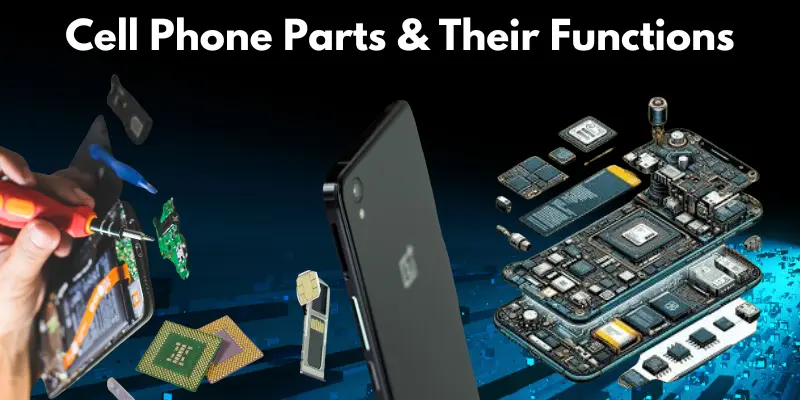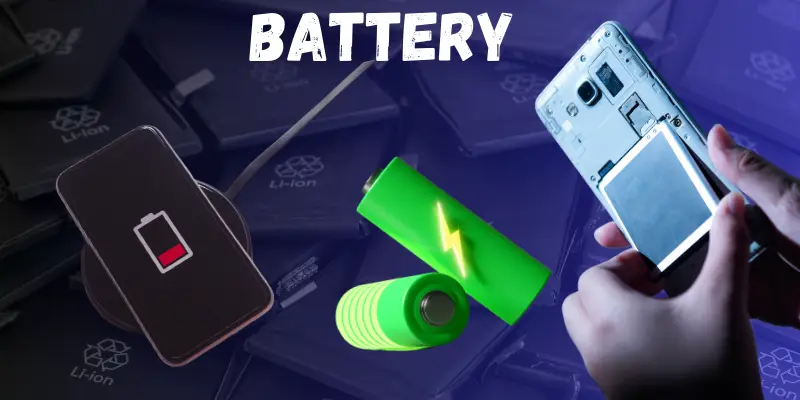Cell Phone Parts & Their Functions
Published: 25 Oct 2024
Have you ever wondered how your mobile phone works? A Mobile Phone is made up of numerous key parts, each serving an important function. From taking selfies with the camera to texting your friends, each part plays a specific role.
Join us on an exciting journey to explore these amazing Parts of Mobile Phones and discover how they work together to make your phone an amazing tool for fun and communication.

Basic Parts of Mobile Phone
Mobile phones consist of essential components like the display screen, battery, CPU, camera, and storage, each playing a vital role in user experience. Together, these parts enable communication, multimedia, and seamless app functionality, making smartphones indispensable in daily life.
Display Screen
The display screen is one of the most crucial components of a Cell Phone, serving as the primary interface through which users interact with their device. The Display Screen is where all user interactions occur, from browsing apps to reading messages and watching videos. It holds everything from gaming to productivity, making it a key consideration for users when choosing a Smartphone.
Battery
This is a vital component of a mobile phone, providing the energy needed for all its functions. Most smartphones use lithium-ion or lithium-polymer batteries, which are lightweight and efficient. The battery’s capacity, measured in milliampere-hours (mAh), indicates how long your phone can run before needing a recharge.

CPU
The Central Processor Unit serves as the Central Control Unit of a mobile phone, whether it’s an Android device or an Apple iPhone. It oversees all functions and handles the processing tasks required for smooth operation. CPU is responsible for executing commands and running apps. It determines how quickly your phone performs tasks, such as opening applications, playing games, and browsing the internet.
Camera
It is a key feature of Cell Phones, allowing users to capture photos and videos easily. Most smartphones come with both front and rear cameras, enabling selfies and landscape shots. Modern cameras often include advanced features like autofocus, image stabilization, and various shooting modes to improve picture & video quality.
Storage
Mobile Storage is a vital part of this handheld device. It determines how much data you can save, like apps, photos, and music. RAM helps your phone to run multiple apps smoothly while ROM stores your operating system and personal files. Some phones allow for expandable storage with MicroSD Cards, giving you extra space.
Sim Card Slot
The SIM Card Slot is a key part of a mobile phone, allowing it to connect with a network. It holds a SIM card, which is essential for making calls, sending texts, and using mobile data. Some phones feature dual SIM slots, enabling easy switching between two numbers.

Ports (USB, Headphone, Jack)
These are essential components of this electronic device that allow for connectivity and charging. Normally ports include the USB Port for charging and data transfer and the headphone, jack for audio output. Some Smartphones feature additional ports, such as HDMI for video output. These connections enable users to link their devices to chargers, headphones, and other accessories.
Speaker and Microphone
The speaker and microphone are vital parts. The speaker produces sound for calls, music, and videos. It allows you to hear audio. The microphone captures your voice during calls and recordings.
Sensors
Common sensors include the Accelerometer, which measures movement and orientation, allowing for auto-rotation of the screen. The gyroscope improves navigation and gaming experiences by detecting changes in position. Proximity sensors turn off the display during calls when the phone is held to your ear, saving battery life.
Operating System (OS)
The operating system (OS) is the software that runs on your mobile phone, managing both hardware and applications. It provides the user interface, allowing you to interact with your device through menus and icons. Popular mobile operating systems include Android and IOS, each offering unique features and app ecosystems. The OS handles tasks like multitasking, notifications, and security, ensuring your phone runs smoothly.
Enjoyed this post? Here are some more you might find interesting.
Conclusion
Every Part of a Mobile Phone plays a vital role in ensuring this electronic device functions smoothly and meets your needs. By familiarizing yourself with these features, you can make informed choices and optimize the use of your mobile phone, making it an essential tool in your daily life
FAQs
What is the purpose of the processor?
The processor handles all the calculations and tasks, making the phone run apps and perform functions smoothly.
What role do sensors play?
Sensors detect physical conditions, enabling features like screen rotation, navigation, and battery-saving functions during calls.
Why is storage important?
Storage determines how much data you can save, including apps, photos, and music, affecting your phone’s overall performance.
What are the main parts of a mobile phone?
The main parts include the display, battery, processor, camera, storage, SIM card slot, ports, speaker, microphone, sensors, and operating system.

- Be Respectful
- Stay Relevant
- Stay Positive
- True Feedback
- Encourage Discussion
- Avoid Spamming
- No Fake News
- Don't Copy-Paste
- No Personal Attacks

- Be Respectful
- Stay Relevant
- Stay Positive
- True Feedback
- Encourage Discussion
- Avoid Spamming
- No Fake News
- Don't Copy-Paste
- No Personal Attacks





